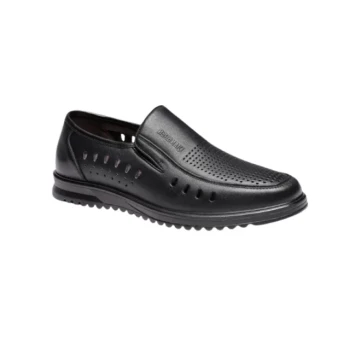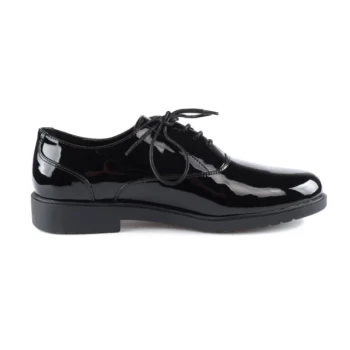In short, treating leather with a conditioner or oil is a critical step in breaking in new boots because it restores moisture to the leather's fiber structure. This added moisture lubricates the fibers, making them more pliable and allowing the stiff material to stretch and conform to the shape of your foot more easily.
The core principle is that conditioning makes leather more flexible, accelerating the break-in period. However, the goal is strategic softening, not oversaturation, as too much conditioner can weaken the leather's supportive structure.
The Science of Leather: Why New Boots Are Stiff
To understand why conditioning works, you first have to understand the material itself. Leather is not a uniform fabric; it's a complex natural structure.
Leather as a Network of Fibers
Leather is primarily composed of a dense, interwoven network of protein fibers called collagen. The tightness and orientation of this weave give leather its renowned strength and durability.
The Impact of Tanning
During the tanning process, these fibers are stabilized to prevent them from decaying. This process removes much of the original moisture and fat, which can leave the fiber bundles stiff and resistant to bending.
The Role of Natural Oils
In its natural state, the hide contains fats and oils that lubricate the collagen fibers, allowing them to slide against each other. New, stiff boots are essentially dehydrated, with their fibers locked in place.
How Conditioners Accelerate the Break-In Process
Applying a conditioner is essentially reintroducing this necessary lubrication into the leather's structure. This has a direct and immediate effect on the break-in process.
Restoring Moisture and Lubrication
Conditioners, oils, and creams are designed to penetrate the surface of the leather. They deliver moisture and fatty compounds deep into the fiber network.
Increasing Fiber Flexibility
This restored moisture acts as an internal lubricant. It allows the thousands of tiny collagen fibers to move more freely, dramatically increasing the leather's overall flexibility.
Conforming to Your Foot
With its fibers now able to shift and move, the leather can more easily stretch and mold. The pressure and heat from your foot's movement during wear will guide this stretching, causing the boot to form a custom fit around your unique anatomy.
Understanding the Trade-offs: The Dangers of Over-Conditioning
While conditioning is beneficial, it is a tool that must be used with care. Applying too much product, too often, can cause more harm than good.
Weakening the Leather Structure
The reference correctly warns against over-conditioning. When leather becomes oversaturated, the fiber network can become too loose and lose its tensile strength. This makes the boot less supportive and more susceptible to damage.
Risk of Permanent Stretching
Over-softened leather can easily stretch beyond what is needed for a comfortable fit. This can ruin the intended shape and structural integrity of the boot, particularly in the heel and ankle areas where support is critical.
Clogging the Pores
Heavy, wax-based conditioners can sometimes clog the natural pores in the leather. This traps moisture inside and prevents the material from breathing, which can lead to discomfort and potential material rot over time.
A Practical Guide to Conditioning Your Boots
Your approach should be guided by your specific goal. Use the right amount of conditioner to achieve your objective without compromising the integrity of your boots.
- If your primary focus is breaking in brand new, stiff boots: Apply a light, even coat of a quality conditioner to the entire boot, paying special attention to flex points like the vamp (across the ball of the foot) and the ankle.
- If your primary focus is general maintenance: Condition your boots only when they look or feel dry, typically every 3-6 months depending on use and climate.
- If your primary focus is avoiding damage: Always test a new product on a small, hidden area first and apply it in thin layers, allowing each to absorb fully before deciding if more is needed.
Properly conditioning your leather boots is the key to transforming them from a stiff, unforgiving necessity into a comfortable, personalized extension of your foot.
Summary Table:
| Aspect | Effect of Conditioning | Key Consideration |
|---|---|---|
| Fiber Flexibility | Lubricates collagen fibers, allowing them to move freely. | Increases pliability for easier stretching. |
| Break-In Speed | Dramatically accelerates the process of conforming to your foot. | Strategic softening is the goal. |
| Structural Integrity | Restores natural oils lost during tanning. | Over-conditioning can weaken the leather's support. |
| Long-Term Fit | Helps the boot mold to your unique foot shape. | Prevents permanent, unwanted stretching if done correctly. |
Ready to experience perfectly broken-in boots from the start?
As a large-scale manufacturer, 3515 produces a comprehensive range of durable footwear for distributors, brand owners, and bulk clients. Our expertise ensures every pair is crafted for optimal comfort and longevity.
Contact us today to discuss your footwear needs and discover how we can deliver quality that fits your business.
Related Products
- Wholesale Leather Work Boots with Customizable Wedge Sole for Brands
- Wholesale Comfort Leather Business Shoes with Dial Lacing System
- Durable Leather Work Boots for Wholesale & Custom Manufacturing
- Durable Leather Work Boots for Wholesale & Custom OEM Manufacturing
- Durable Leather Work Boots Wholesale Manufacturer & Custom Factory
People Also Ask
- How should new leather work boots be broken in? A Guide to Comfort and Durability
- What are the advantages of leather work boots? Unmatched Durability & Custom Fit
- How does cleaning your work boots help in their maintenance? Extend Lifespan & Boost Safety
- What are the best practices for storing leather work boots? Preserve Your Investment for Years
- What maintenance tips are recommended for leather safety footwear? Extend Lifespan & Preserve Safety



















